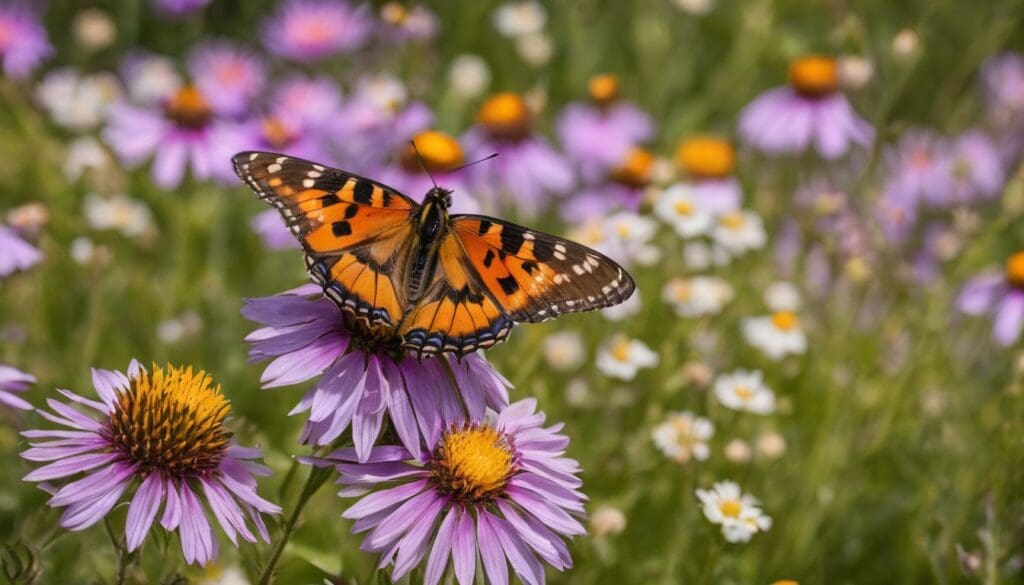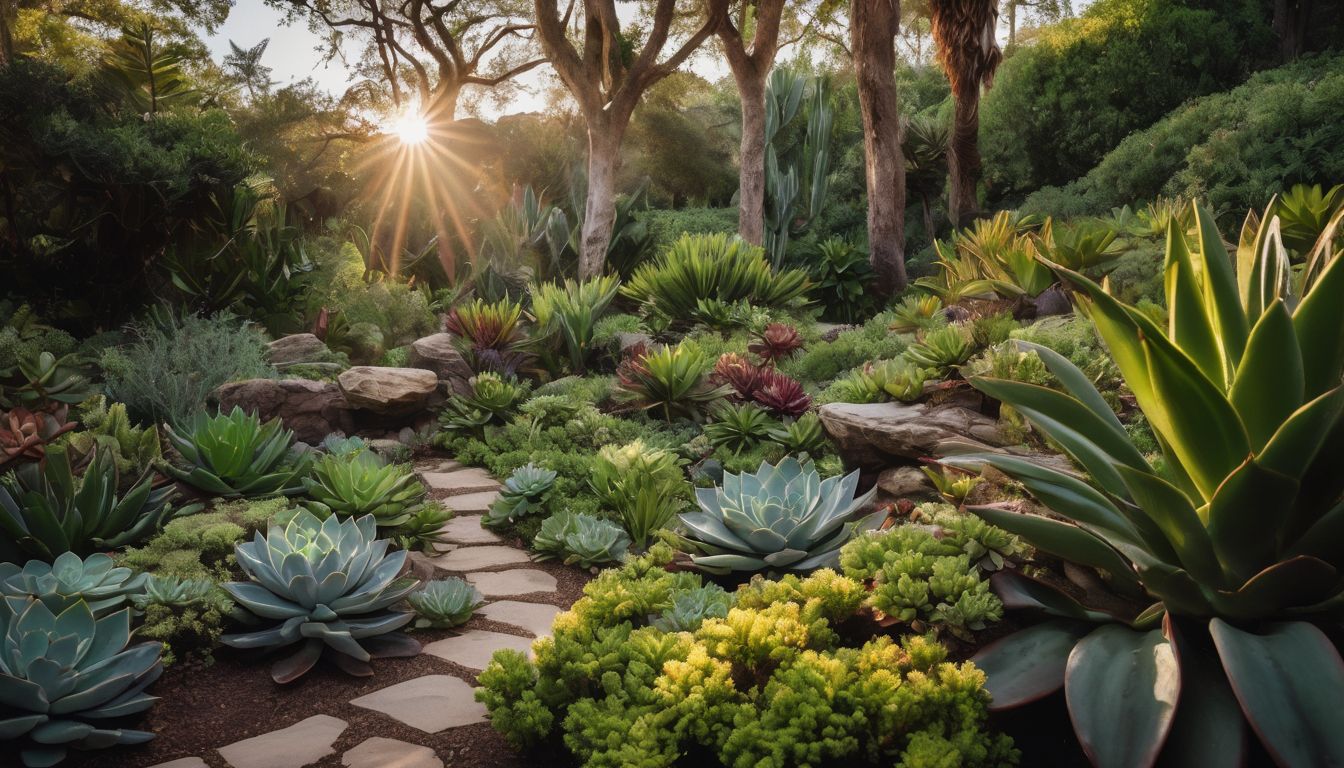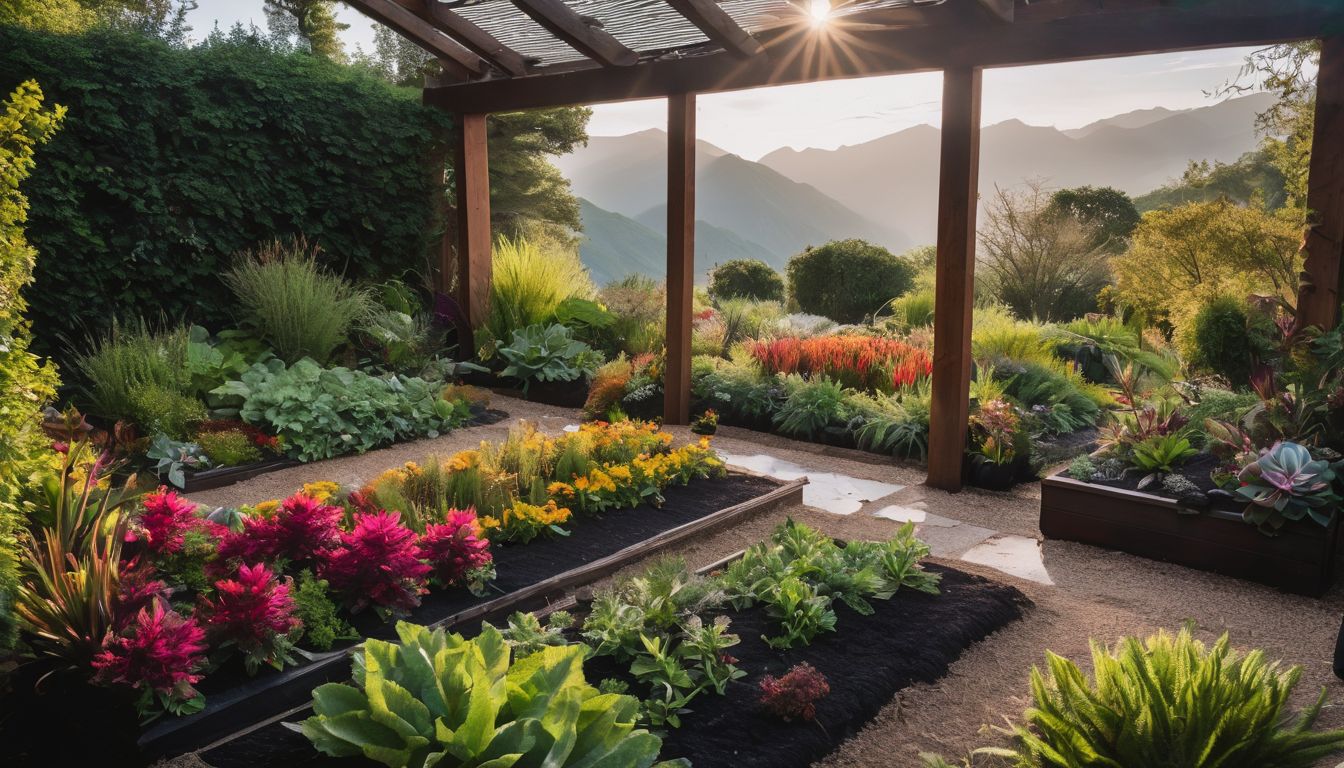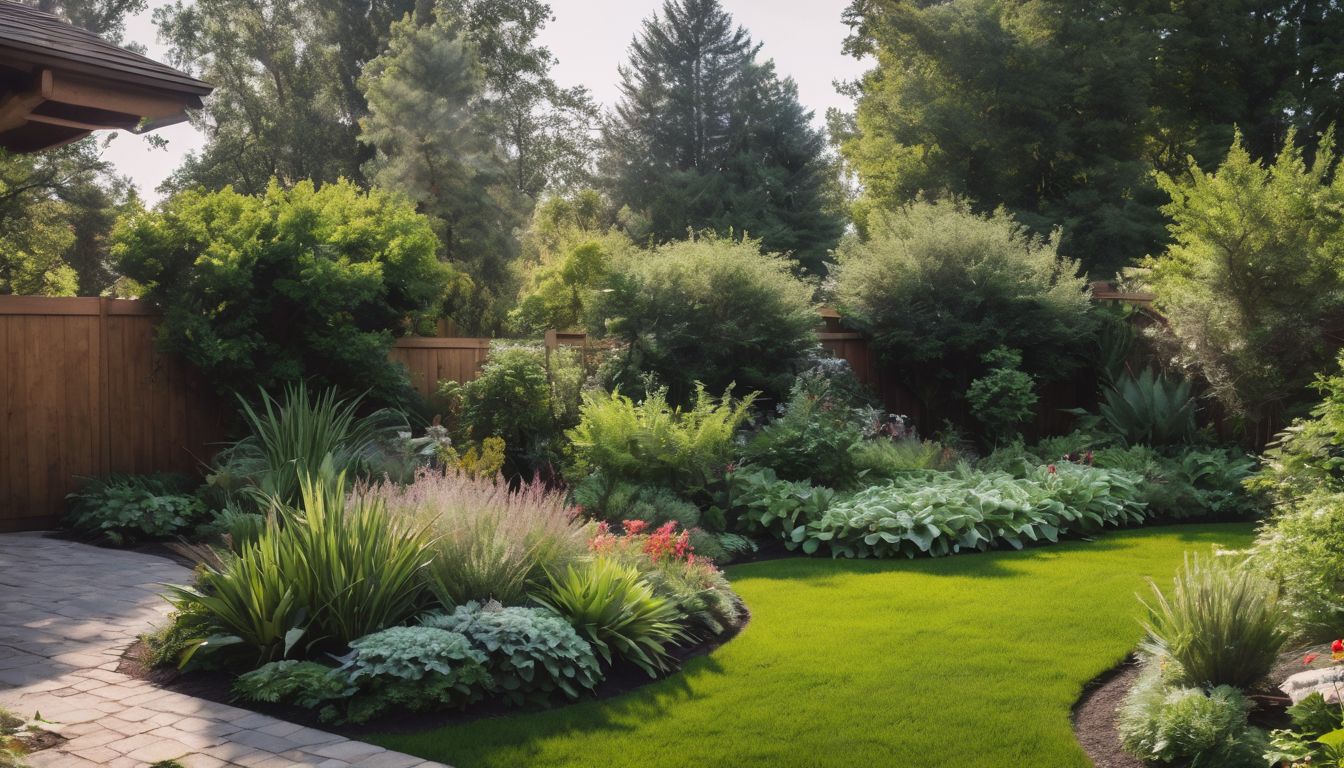Many people want a lovely garden without hurting the planet. Traditional lawns need lots of water and chemicals, which isn’t good for nature. This blog will show you how to make your garden green in more ways than one with easy-to-follow alternatives.
Keep reading and grow differently!
Key Takeaways
- Traditional lawns often require excessive water and chemicals, but eco – friendly alternatives like ground covers can reduce this impact on the environment.
- Ground covers such as sedges, clover, and thyme need less maintenance and no chemical treatments while supporting biodiversity in your garden.
- Native plants are great for eco – friendly lawns because they are adapted to local conditions, helping to conserve water and attract local wildlife.
- Wildflower meadows and no-mow or low-mow grasses offer colourful, low-upkeep options that encourage pollinators and save water.
- Using rain gardens, rock gardens, mulch, gravel, or hardscaping can manage stormwater runoff effectively while creating attractive lawn substitutes.
Why Choose Eco-Friendly Lawn Alternatives?
Traditional lawns have a significant environmental impact, often requiring excessive water and chemical use. By opting for eco-friendly lawn alternatives, you can reduce these impacts and create a more biodiverse and sustainable garden.
Environmental impact of traditional lawns
Traditional lawns have a surprisingly heavy impact on our environment. They often require vast amounts of water to stay lush and green, which isn’t ideal in regions where water is scarce.
This excessive use leads to drought stress, especially during the hot months when water conservation should be a priority. Lawns also frequently depend on chemical fertilisers and pesticides.
These substances can contaminate local waterways, harming wildlife and disrupting ecosystems.
Beyond chemicals and water usage, typical grass lawns contribute to reduced biodiversity. Their monoculture nature provides little support for local wildlife like bees, butterflies, and birds that rely on a variety of plants for their habitats.
In contrast, exploring eco-friendly lawn alternatives supports sustainable landscaping while encouraging diverse life in your garden space. Let’s look at how reducing both water and chemical use with these alternatives can make your yard more environmentally friendly.
Reduction of water and chemical use
By transitioning to eco-friendly lawn alternatives, you can significantly reduce water and chemical use in your garden. These environmentally conscious choices not only benefit the planet but also contribute to a more sustainable approach to landscaping.
Embracing ground covers, native plants, and other non-traditional lawn options allows for reduced reliance on watering and harmful chemicals that can impact the environment negatively.
Ground covers like sedges, clover, and thyme offer effective coverage while requiring minimal water and no chemical treatments. Additionally, native plants are better adapted to local climate conditions which reduces the need for excessive irrigation or pesticide use.
Increased biodiversity
Choosing eco-friendly lawn alternatives can significantly contribute to increasing biodiversity in your garden. By incorporating a variety of ground covers and native plants, you can create a habitat that attracts and supports a diverse range of wildlife, including pollinators such as bees and butterflies.
This not only adds beauty to your outdoor space but also plays a crucial role in maintaining the delicate balance of the ecosystem.
Integrating different plant species into your garden promotes resilience against pests and diseases while providing food sources for various creatures. The use of organic gardening practices further enhances the overall health of the environment, making it an appealing option for those aiming to reduce their ecological footprint.
Embracing eco-friendly lawn alternatives goes beyond aesthetics; it becomes a vital step towards sustainable living, nurturing our green spaces for generations to come through responsible environmental stewardship.
Ground Covers
Ground covers offer a low-maintenance alternative to traditional lawns, providing benefits such as erosion control, weed suppression, and reduced water usage. Sedges, clover, and thyme are recommended options for those looking to incorporate ground covers into their eco-friendly garden.
Benefits of using ground covers
Ground covers offer numerous benefits for eco-conscious gardeners. They act as a natural weed suppressant, reducing the need for chemical herbicides and promoting soil health. Additionally, ground covers minimise erosion by protecting the soil from wind and water, while also providing insulation to help retain moisture during dry periods.
These low-growing plants create a lush green carpet that requires minimal maintenance, making them an ideal choice for those seeking environmentally responsible gardening solutions.
Furthermore, ground covers contribute to biodiversity by providing habitat and food sources for beneficial insects and wildlife in the garden. Sedges, clover, and thyme are recommended options that not only enhance the visual appeal of outdoor spaces but also support sustainable lawn maintenance and promote water-saving lawn options.
Recommended options (sedges, clover, thyme)
For a low-maintenance and environmentally friendly lawn, consider the following recommended options:
- Sedges are hardy and drought – resistant, making them ideal for areas with limited water resources. They also provide excellent erosion control and attract wildlife.
- Clover is an excellent ground cover that improves soil health by fixing nitrogen. It requires minimal maintenance and adds nutrients to the soil.
- Thyme is a fragrant and attractive option that creates a lush carpet of greenery. It is also drought – tolerant and requires little to no mowing.
Native Plants
Using native plants in your garden not only promotes biodiversity, but also requires less maintenance and resources. Check out the recommended options for your specific region to create a beautiful and sustainable landscape.
Benefits of using native plants
Using native plants in your garden offers a range of benefits. These plants are well-adapted to the local climate and soil, requiring less water and maintenance. By choosing native species, you can create a vibrant habitat for local wildlife while promoting biodiversity.
Additionally, native plants help conserve water resources by reducing the need for irrigation and decreasing overall water usage in your garden.
Moreover, incorporating native plants into your landscaping supports environmental conservation efforts and contributes to the preservation of local ecosystems. Embracing these natural grass substitutes not only enhances the beauty of your outdoor space but also fosters sustainable gardening practices that align with eco-conscious yard design principles.
Recommended options for different regions
When considering eco-friendly lawn alternatives, it’s essential to choose options that are well-suited to the specific region. Here are some recommended alternatives for different regions:
- For dry and arid regions, consider using drought-resistant ground covers such as sedges or low-maintenance grasses like buffalo grass. These options require less water and can thrive in challenging conditions.
- In temperate climates, native plants like clover and thyme can be excellent choices for their ability to withstand varying weather patterns and provide habitat for local wildlife.
- Coastal areas can benefit from ground covers like beachgrass or coastal dune plants, which are naturally adapted to sandy soils and salt spray.
- For mountainous regions, consider using native alpine plants that are hardy and can withstand colder temperatures and rocky terrain.
- In urban settings, low – maintenance grasses and wildflower meadows can provide green spaces while reducing the need for extensive maintenance.
Other Lawn Alternatives
– Wildflower meadows provide a natural and colourful alternative to traditional lawns, while also supporting local pollinators and wildlife.
– No-mow and low-mow grasses are a low-maintenance option that requires less water, mowing, and chemical use compared to regular grass lawns.
Wildflower meadows
Wildflower meadows offer a vibrant and biodiverse alternative to traditional lawns. Planting a wildflower meadow in your garden provides essential food and habitat for bees, butterflies, and other pollinators.
These natural spaces also require minimal maintenance once established, making them an excellent eco-friendly lawn option. Additionally, they can thrive in various soil types and are drought-resistant, making them a sustainable choice for environmentally conscious gardeners looking to support local wildlife and reduce their environmental footprint.
Creating a wildflower meadow contributes to the conservation of native plant species while adding beauty and color to outdoor spaces. These dynamic landscapes not only benefit local ecosystems but also provide a charming backdrop for outdoor leisure activities while promoting responsible land stewardship.
No-mow and low-mow grasses
No-mow and low-mow grasses are excellent alternatives for eco-conscious gardeners looking to reduce maintenance and create wildlife-friendly spaces in their yards. These grasses require less mowing, which not only saves time but also reduces the use of lawnmowers that emit greenhouse gases.
They provide habitat for wildlife and help prevent soil erosion due to their deep root systems, making them an environmentally friendly choice for landscaping.
These grasses are drought-resistant, requiring minimal watering once established, reducing water consumption compared to traditional lawns. Additionally, they contribute to increased biodiversity by providing food and shelter for a variety of insects and small animals.
Rain gardens
Rain gardens are an effective way to manage stormwater runoff, preventing soil erosion and reducing water pollution. By using native plants like irises, ferns, and sedges that can tolerate both wet and dry conditions, rain gardens help to absorb excess water while providing habitat for pollinators and wildlife.
These low-maintenance gardens can also enhance the aesthetic appeal of your outdoor space, offering a beautiful and eco-friendly alternative to traditional lawns.
Implementing rain gardens in your yard not only contributes to sustainable landscaping but also helps in conserving water resources by naturally filtering pollutants before they reach groundwater systems.
Rock gardens
Rock gardens are an excellent eco-friendly lawn alternative, providing both aesthetic appeal and environmental benefits. Utilising rocks as the main feature reduces the need for water and maintenance, making it a sustainable option for green spaces.
The natural texture and composition of rock gardens create habitats for various plant species, promoting biodiversity in outdoor areas.
Integrating rock gardens into your landscaping not only adds visual interest but also supports conservation efforts by reducing water consumption and minimising the use of chemicals.
Mulch and gravel
Mulch and gravel are excellent alternatives to traditional lawns, offering low-maintenance and environmentally friendly solutions. Using organic mulch like wood chips or straw helps retain soil moisture, suppress weed growth, and provide insulation for plant roots.
Gravel, on the other hand, is durable and can be used in creative ways such as creating pathways or borders. Both options reduce the need for water consumption while adding texture and visual interest to outdoor spaces.
When combined with native plants or ground covers, mulch and gravel contribute to a sustainable landscape that supports biodiversity.
Hardscaping options
Hardscaping options provide low-maintenance and environmentally friendly alternatives to traditional lawns. Using materials such as gravel, stone, and pavers can reduce water consumption and eliminate the need for harmful chemicals.
By creating pathways, patios, or retaining walls with these elements, you can enhance the aesthetic appeal of your garden while minimising environmental impact. Additionally, hardscaping creates habitat for beneficial insects and helps control soil erosion in your green space.
After exploring hardscaping options for an eco-friendly garden, it’s essential to consider tips for maintaining a sustainable outdoor space that supports biodiversity.
Tips for Maintaining an Eco-Friendly Lawn
Maintain an eco-friendly lawn by avoiding chemicals, using proper watering techniques, and implementing the right mowing and maintenance practices. Read on to learn more about how to create a green garden with sustainable options.
Avoiding chemicals
Use organic fertilisers and natural pest control methods to keep your eco-friendly lawn healthy. Choose natural alternatives such as compost, mulch, and organic fertilisers high in nitrogen for a green garden.
These options nourish the soil without harmful chemicals. Additionally, consider using insect-repellent plants like marigolds or companion planting to deter pests naturally.
Regularly aerate the soil to improve water absorption and reduce the need for chemical treatments like herbicides or pesticides. This allows natural nutrients from organic matter to penetrate deeper into the ground improving root health of native plants which are drought-resistant landscaping choices for environmentally friendly yards.
Proper watering techniques
To maintain an eco-friendly lawn, it’s crucial to water deeply and infrequently. This encourages deep root growth and reduces water waste. Consider using a rain gauge to track rainfall and only supplement with additional watering when needed.
Watering in the early morning helps prevent evaporation, while watering in the evening can lead to mould and diseases.
Adjusting sprinklers to avoid overwatering non-grass alternatives is essential for their healthy growth. Mulching around plants retains moisture, reducing the need for frequent watering.
When hand-watering, use a soaker hose or drip irrigation system which delivers water directly to the roots without wastage.
Mowing and maintenance
To maintain an eco-friendly lawn, regular mowing and maintenance are essential. Set the lawnmower at a higher level to encourage deeper root growth of the grass or ground cover. This will reduce evaporation and help retain soil moisture, promoting drought resistance.
Regularly sharpening the lawnmower blades is crucial in achieving clean cuts that promote healthy plant regeneration and discourage disease spread. Additionally, consider leaving grass clippings on the lawn as they act as a natural mulch, providing nutrients while reducing waste.
Regular weeding ensures that unwanted invasive species do not take over your eco-friendly lawn space. Using organic methods to control pests and weeds helps maintain a healthy balance within your garden’s ecosystem without harming beneficial insects and wildlife.
Conclusion
In conclusion, transforming your lawn into an eco-friendly space can benefit the environment and support biodiversity. Ground covers like sedges, clover, and thyme offer low-maintenance alternatives to traditional grass lawns.
Additionally, incorporating native plants, wildflower meadows, or rock gardens can further enhance your green garden while minimising water and chemical use. With proper care and consideration for nature, you can create a beautiful and sustainable outdoor space for all to enjoy.
FAQs
1. What are eco-friendly lawn alternatives for a green garden?
Eco-friendly lawn alternatives include non-grass ground cover, native plant gardens, and drought-resistant landscaping to create an environmentally friendly garden that requires low maintenance.
2. How can I design a wildlife-friendly garden?
To design a wildlife-friendly garden, use organic lawn alternatives and plant native species to attract local birds and insects while practising earth-friendly gardening techniques.
3. Are there any benefits to choosing non-traditional lawn choices over regular grass?
Yes, choosing non-traditional lawn options like natural garden care with native plants or organic ground cover helps conserve water, supports local ecosystems, and reduces the need for chemical fertilisers.
4. Can eco-conscious ground cover options save me time on garden work?
Certainly! Eco-conscious ground cover is designed to be low-maintenance which means less mowing and upkeep compared to traditional lawns, leading you towards greener gardening without the extra effort.
5. Is it possible to have an attractive outdoor space using Earth-friendly landscaping?
Absolutely! With environmentally-friendly landscaping such as wildlife-friendly elements and natural designs, your outdoor spaces can look beautiful while still being kinder to our planet.





